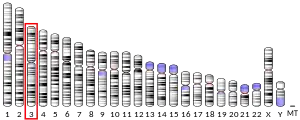RBM5
RNA-binding protein 5 is a protein that in humans is encoded by the RBM5 gene.[5][6]
| RBM5 | |||||||||||||||||||||||||||||||||||||||||||||||||||
|---|---|---|---|---|---|---|---|---|---|---|---|---|---|---|---|---|---|---|---|---|---|---|---|---|---|---|---|---|---|---|---|---|---|---|---|---|---|---|---|---|---|---|---|---|---|---|---|---|---|---|---|
| |||||||||||||||||||||||||||||||||||||||||||||||||||
| Identifiers | |||||||||||||||||||||||||||||||||||||||||||||||||||
| Aliases | RBM5, G15, LUCA15, RMB5, H37, RNA binding motif protein 5, LUCA-15 | ||||||||||||||||||||||||||||||||||||||||||||||||||
| External IDs | OMIM: 606884 MGI: 1933204 HomoloGene: 21177 GeneCards: RBM5 | ||||||||||||||||||||||||||||||||||||||||||||||||||
| |||||||||||||||||||||||||||||||||||||||||||||||||||
| |||||||||||||||||||||||||||||||||||||||||||||||||||
| |||||||||||||||||||||||||||||||||||||||||||||||||||
| |||||||||||||||||||||||||||||||||||||||||||||||||||
| Wikidata | |||||||||||||||||||||||||||||||||||||||||||||||||||
| |||||||||||||||||||||||||||||||||||||||||||||||||||
References
- GRCh38: Ensembl release 89: ENSG00000003756 - Ensembl, May 2017
- GRCm38: Ensembl release 89: ENSMUSG00000032580 - Ensembl, May 2017
- "Human PubMed Reference:". National Center for Biotechnology Information, U.S. National Library of Medicine.
- "Mouse PubMed Reference:". National Center for Biotechnology Information, U.S. National Library of Medicine.
- Timmer T, Terpstra P, van den Berg A, Veldhuis PM, Ter Elst A, Voutsinas G, Hulsbeek MM, Draaijers TG, Looman MW, Kok K, Naylor SL, Buys CH (Aug 1999). "A comparison of genomic structures and expression patterns of two closely related flanking genes in a critical lung cancer region at 3p21.3". Eur J Hum Genet. 7 (4): 478–486. doi:10.1038/sj.ejhg.5200334. PMID 10352938.
- "Entrez Gene: RBM5 RNA binding motif protein 5".
Further reading
- Timmer T, Terpstra P, van den Berg A, et al. (1999). "An evolutionary rearrangement of the Xp11.3-11.23 region in 3p21.3, a region frequently deleted in a variety of cancers". Genomics. 60 (2): 238–240. doi:10.1006/geno.1999.5878. PMID 10486216.
- Oh JJ, Grosshans DR, Wong SG, Slamon DJ (1999). "Identification of differentially expressed genes associated with HER-2/neu overexpression in human breast cancer cells". Nucleic Acids Res. 27 (20): 4008–4017. doi:10.1093/nar/27.20.4008. PMC 148668. PMID 10497265.
- Scanlan MJ, Gordan JD, Williamson B, et al. (1999). "Antigens recognized by autologous antibody in patients with renal-cell carcinoma". Int. J. Cancer. 83 (4): 456–464. doi:10.1002/(SICI)1097-0215(19991112)83:4<456::AID-IJC4>3.0.CO;2-5. PMID 10508479.
- Sutherland LC, Edwards SE, Cable HC, et al. (2000). "LUCA-15-encoded sequence variants regulate CD95-mediated apoptosis". Oncogene. 19 (33): 3774–3781. doi:10.1038/sj.onc.1203720. PMID 10949932.
- Oh JJ, West AR, Fishbein MC, Slamon DJ (2002). "A candidate tumor suppressor gene, H37, from the human lung cancer tumor suppressor locus 3p21.3". Cancer Res. 62 (11): 3207–3213. PMID 12036935.
- Strausberg RL, Feingold EA, Grouse LH, et al. (2003). "Generation and initial analysis of more than 15,000 full-length human and mouse cDNA sequences". Proc. Natl. Acad. Sci. U.S.A. 99 (26): 16899–16903. Bibcode:2002PNAS...9916899M. doi:10.1073/pnas.242603899. PMC 139241. PMID 12477932.
- Mourtada-Maarabouni M, Sutherland LC, Meredith JM, Williams GT (2003). "Simultaneous acceleration of the cell cycle and suppression of apoptosis by splice variant delta-6 of the candidate tumour suppressor LUCA-15/RBM5". Genes Cells. 8 (2): 109–119. doi:10.1046/j.1365-2443.2003.00619.x. PMID 12581154. S2CID 24099427.
- Ota T, Suzuki Y, Nishikawa T, et al. (2004). "Complete sequencing and characterization of 21,243 full-length human cDNAs". Nat. Genet. 36 (1): 40–45. doi:10.1038/ng1285. PMID 14702039.
- Rintala-Maki ND, Sutherland LC (2005). "LUCA-15/RBM5, a putative tumour suppressor, enhances multiple receptor-initiated death signals". Apoptosis. 9 (4): 475–484. doi:10.1023/B:APPT.0000031455.79352.57. PMID 15192330. S2CID 9436571.
- Rintala-Maki ND, Abrasonis V, Burd M, Sutherland LC (2005). "Genetic instability of RBM5/LUCA-15/H37 in MCF-7 breast carcinoma sublines may affect susceptibility to apoptosis". Cell Biochem. Funct. 22 (5): 307–313. doi:10.1002/cbf.1106. PMID 15338470. S2CID 41472130.
- Gerhard DS, Wagner L, Feingold EA, et al. (2004). "The status, quality, and expansion of the NIH full-length cDNA project: the Mammalian Gene Collection (MGC)". Genome Res. 14 (10B): 2121–2127. doi:10.1101/gr.2596504. PMC 528928. PMID 15489334.
- Stelzl U, Worm U, Lalowski M, et al. (2005). "A human protein-protein interaction network: a resource for annotating the proteome". Cell. 122 (6): 957–968. doi:10.1016/j.cell.2005.08.029. hdl:11858/00-001M-0000-0010-8592-0. PMID 16169070. S2CID 8235923.
- Mourtada-Maarabouni M, Keen J, Clark J, et al. (2006). "Candidate tumor suppressor LUCA-15/RBM5/H37 modulates expression of apoptosis and cell cycle genes". Exp. Cell Res. 312 (10): 1745–1752. doi:10.1016/j.yexcr.2006.02.009. PMID 16546166.
- Oh JJ, Razfar A, Delgado I, et al. (2006). "3p21.3 tumor suppressor gene H37/Luca15/RBM5 inhibits growth of human lung cancer cells through cell cycle arrest and apoptosis". Cancer Res. 66 (7): 3419–3427. doi:10.1158/0008-5472.CAN-05-1667. PMID 16585163.
- Masdeu C, Faure H, Coulombe J, et al. (2006). "Identification and characterization of Hedgehog modulator properties after functional coupling of Smoothened to G15". Biochem. Biophys. Res. Commun. 349 (2): 471–479. doi:10.1016/j.bbrc.2006.07.216. PMID 16945339.
- Olsen JV, Blagoev B, Gnad F, et al. (2006). "Global, in vivo, and site-specific phosphorylation dynamics in signaling networks". Cell. 127 (3): 635–648. doi:10.1016/j.cell.2006.09.026. PMID 17081983. S2CID 7827573.
External links
- RBM5 human gene location in the UCSC Genome Browser.
- RBM5 human gene details in the UCSC Genome Browser.
This article is issued from Wikipedia. The text is licensed under Creative Commons - Attribution - Sharealike. Additional terms may apply for the media files.





